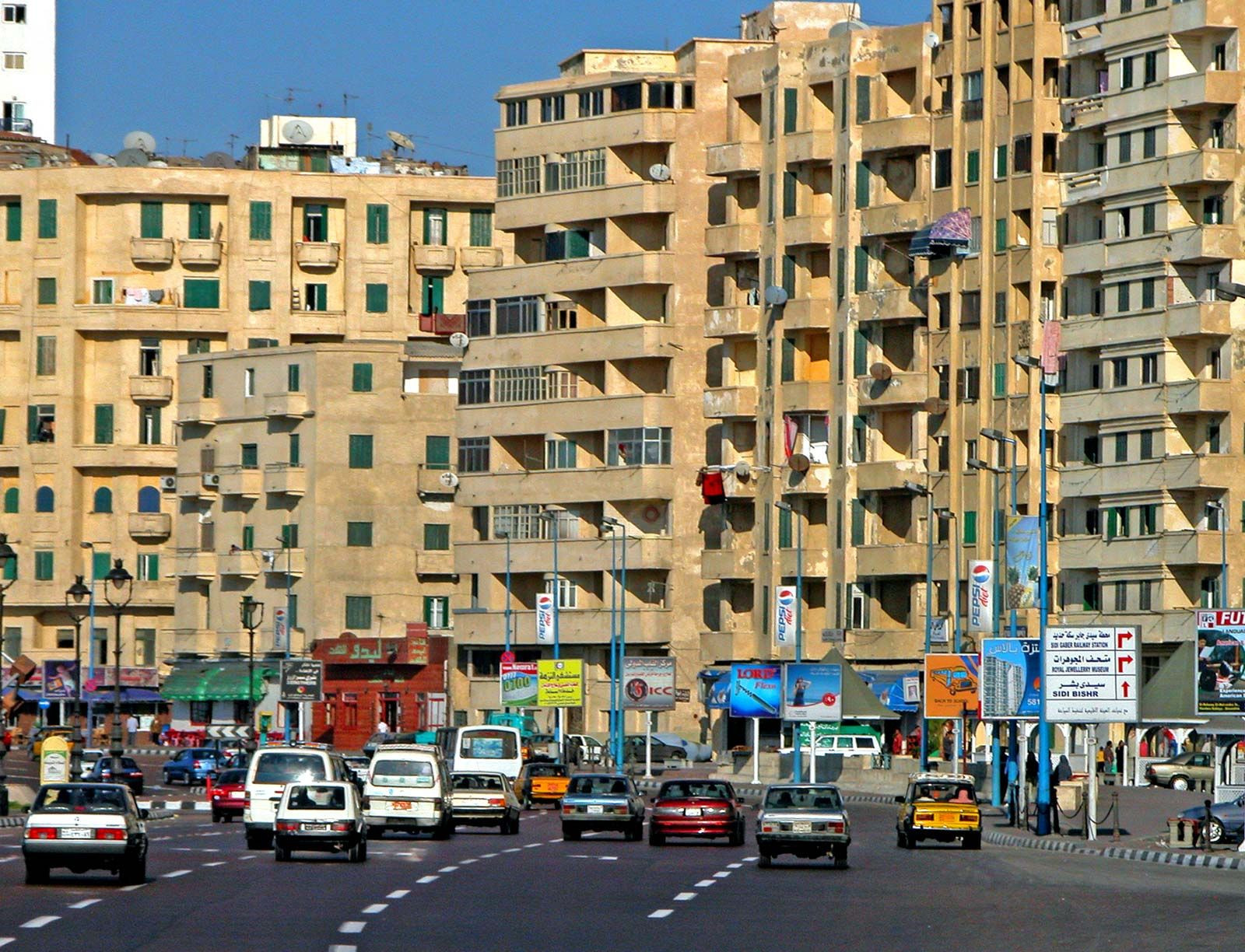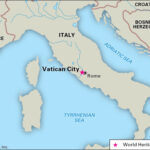Alexandria, a city steeped in history and culture, holds a prominent place in the narrative of the Mediterranean world. Once a beacon of Hellenistic scholarship and science, Alexandria served as the capital of Egypt for nearly a thousand years, from its foundation by Alexander the Great in 332 BCE until its surrender to Arab forces in 642 CE. Today, Alexandria stands as one of Egypt’s largest cities, its principal seaport, and a significant industrial hub. But Where Is Alexandria exactly?
 The Mosque of Abu al-Abbas al-Mursi in Alexandria, Egypt, showcasing Islamic architecture in the coastal city.
The Mosque of Abu al-Abbas al-Mursi in Alexandria, Egypt, showcasing Islamic architecture in the coastal city.
Alexandria is strategically located on the coast of the Mediterranean Sea, at the western edge of the fertile Nile River delta. Positioned approximately 114 miles (183 km) northwest of Cairo, it resides within Lower Egypt. Geographically, Alexandria’s city area spans about 116 square miles (300 square km). As of 2006, the city boasted a population of over 4 million inhabitants, underscoring its vital urban significance in Egypt.
Alexandria’s Location and Geography
Alexandria’s unique geographical setting has profoundly shaped its character and history. Extending along a narrow limestone ridge, the city is bordered by the Mediterranean Sea to the north and Lake Mariout (Maryūṭ), a saltwater lake, to the south. This ridge, varying between 1 to 2 miles (1.6 to 3.2 km) in width, effectively separates the lake from the mainland.
Mediterranean Coast and Nile Delta
The city’s position on the Mediterranean coast is paramount to its identity. Alexandria thrives at the edge of the Nile Delta, the expansive triangular region where the Nile River branches out and empties into the Mediterranean. This delta region is known for its agricultural richness and historical importance as the cradle of Egyptian civilization. Alexandria’s coastal location made it a natural gateway for trade and cultural exchange between Egypt and the wider Mediterranean world.
Proximity to Cairo and Lower Egypt
Situated in Lower Egypt, the northernmost part of the country, Alexandria is relatively close to the current capital, Cairo. While Cairo is the modern political and cultural heart of Egypt, Alexandria retains its significance as a major economic and historical center. The proximity to Cairo, yet distinct coastal identity, gives Alexandria a unique position within Egypt.
City Site and Landscape
The cityscape of Alexandria is distinctive. A key geographical feature is the hourglass-shaped promontory formed by the Heptastadion, an ancient mole that connected the island of Pharos to the mainland. This land bridge created two natural harbors: the Eastern Harbour and the Western Harbour, crucial for Alexandria’s maritime activities throughout history. The city stretches for 25 miles (40 km) from east to west along the limestone ridge, offering a striking contrast between the urban sprawl and the surrounding waters.
 Aerial view of Alexandria, Egypt, highlighting its urban landscape and Mediterranean coastline.
Aerial view of Alexandria, Egypt, highlighting its urban landscape and Mediterranean coastline.
Historical Significance of Alexandria
Alexandria’s historical legacy is as compelling as its location. Founded by Alexander the Great, it quickly rose to prominence as a major center of Hellenistic culture and learning.
Founding by Alexander the Great
The city’s story begins with Alexander the Great, who envisioned and founded Alexandria in 332 BCE. His ambition was to create a grand city that would bear his name and become a center of civilization. Alexandria quickly surpassed other cities in the region, becoming a vibrant metropolis and a symbol of Alexander’s vast empire.
Hellenistic Center and Capital of Egypt
For centuries, Alexandria was the intellectual and cultural capital of the Hellenistic world and later of Egypt under the Ptolemaic dynasty. It housed the legendary Library of Alexandria, a beacon of knowledge attracting scholars from across the ancient world. The city was a melting pot of cultures, blending Greek, Egyptian, and other Mediterranean influences.
Role in Trade and Commerce
Alexandria’s strategic coastal location made it a vital hub for trade and commerce. It served as a crucial link between the Mediterranean and the East, facilitating the exchange of goods, ideas, and cultures. Even after the capital moved inland, Alexandria remained an important port city, maintaining its economic significance through maritime trade and craft production.
19th Century Revival
Despite periods of decline, Alexandria experienced a significant revival in the 19th century, driven by the booming cotton industry. This resurgence transformed the city, drawing in both economic prosperity and a wave of Egyptian migration. Alexandria once again became a major urban center, albeit with a more modern and Egyptian character.
Alexandria’s Character and Culture
Alexandria’s cultural identity is as multifaceted as its history. Often described as cosmopolitan, it has historically straddled two worlds: facing the Mediterranean while rooted in Egypt.
Cosmopolitan Nature and Mediterranean Identity
Throughout much of its history, Alexandria has been a truly cosmopolitan city, more connected to the broader Mediterranean world than to its Egyptian hinterland. This Mediterranean identity is reflected in its diverse population, its architectural styles, and its cultural outlook. It has been a city of immigrants, merchants, and travelers, fostering a unique blend of traditions.
Cultural Ambivalence and Egyptian Integration
The city’s identity has been marked by a degree of cultural ambivalence, caught between its Mediterranean and Egyptian affiliations. However, the 19th-century revival and the rise of Egyptian nationalism led to a closer integration with the Nile Valley and a strengthening of its Egyptian identity.
Arts and Literature
Alexandria has long been a source of inspiration for artists and writers. Constantine Cavafy, the renowned Greek poet born in Alexandria, drew heavily on the city’s rich past in his works. Lawrence Durrell’s The Alexandria Quartet vividly depicted the decadent cosmopolitanism of the city’s foreign communities in the pre-revolution era. In contrast, Naguib Mahfouz’s Miramar offered a view of a postcolonial Alexandria deeply integrated into Egyptian society.
 Downtown Alexandria, Egypt, depicting the modern cityscape of this major Egyptian urban center.
Downtown Alexandria, Egypt, depicting the modern cityscape of this major Egyptian urban center.
Modern Alexandria as “Second Capital”
Today, Alexandria is often considered Egypt’s “second capital,” a testament to its enduring importance. It remains a vital contributor to the national economy, a major industrial center, and a popular summer destination for both Egyptians and international tourists.
Climate of Alexandria
Alexandria enjoys a Mediterranean climate, distinctly different from the desert climate of much of Egypt.
Mediterranean Climate Influence
The prevailing north wind blowing from the Mediterranean moderates Alexandria’s temperatures, especially during the summer. This coastal influence results in milder summers and wetter winters compared to inland Egypt.
Summer and Winter Weather
Summers in Alexandria are relatively temperate, although humidity can be high in July and August, the hottest months, with average temperatures reaching 87 °F (31 °C). Winters are cool and often stormy, bringing torrential rains and occasional hail. January, the coldest month, sees an average daily temperature of 64 °F (18 °C).
In conclusion, Alexandria is located on Egypt’s Mediterranean coast, west of the Nile Delta, and northwest of Cairo. Its unique location has been pivotal to its history, shaping its cosmopolitan character and its role as a vital Mediterranean port city for millennia. From its ancient wonders to its modern urban vibrancy, Alexandria continues to be a captivating destination, inviting exploration and discovery.


